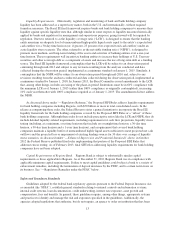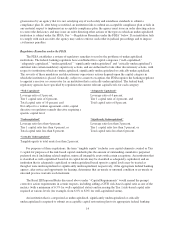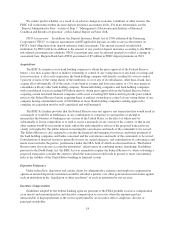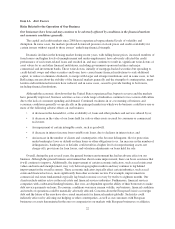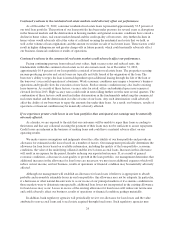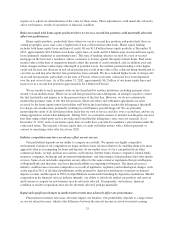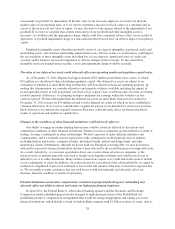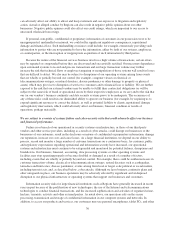Regions Bank 2012 Annual Report Download - page 38
Download and view the complete annual report
Please find page 38 of the 2012 Regions Bank annual report below. You can navigate through the pages in the report by either clicking on the pages listed below, or by using the keyword search tool below to find specific information within the annual report.Item 1A. Risk Factors
Risks Related to the Operation of Our Business
Our businesses have been and may continue to be adversely affected by conditions in the financial markets
and economic conditions generally.
The capital and credit markets since 2008 have experienced unprecedented levels of volatility and
disruption. In some cases, the markets produced downward pressure on stock prices and credit availability for
certain issuers without regard to those issuers’ underlying financial strength.
Dramatic declines in the housing market during recent years, with falling home prices, increased numbers of
foreclosures and higher levels of unemployment and under-employment, have adversely affected the credit
performance of real estate-related loans and resulted in, and may continue to result in, significant write-downs of
asset values by us and other financial institutions, including government-sponsored entities and major
commercial and investment banks. These write-downs, initially of mortgage-backed securities but spreading to
credit default swaps and other securities and loans, have caused many financial institutions to seek additional
capital, to reduce or eliminate dividends, to merge with larger and stronger institutions and, in some cases, to fail.
Reflecting concern about the stability of the financial markets generally and the strength of counterparties, many
lenders and institutional investors have reduced, and in some cases, ceased to provide funding to borrowers,
including financial institutions.
Although the economic slowdown that the United States experienced has begun to reverse and the markets
have generally improved, business activities across a wide range of industries continue to face serious difficulties
due to the lack of consumer spending and demand. Continued weakness in or a worsening of business and
economic conditions generally or specifically in the principal markets in which we do business could have one or
more of the following adverse effects on our business:
• A decrease in the demand for, or the availability of, loans and other products and services offered by us;
• A decrease in the value of our loans held for sale or other assets secured by consumer or commercial
real estate;
• An impairment of certain intangible assets, such as goodwill;
• A decrease in interest income from variable rate loans, due to declines in interest rates; and
• An increase in the number of clients and counterparties who become delinquent, file for protection
under bankruptcy laws or default on their loans or other obligations to us. An increase in the number of
delinquencies, bankruptcies or defaults could result in a higher level of nonperforming assets, net
charge-offs, provisions for loan losses, and valuation adjustments on loans held for sale.
Overall, during the past several years, the general business environment has had an adverse effect on our
business. Although the general business environment has shown some improvement, there can be no assurance that
it will continue to improve. Additionally, the improvement of certain economic indicators, such as real estate asset
values and rents and unemployment, may vary between geographic markets and may continue to lag behind
improvement in the overall economy. These economic indicators typically affect certain industries, such as real
estate and financial services, more significantly than other economic sectors. For example, improvements in
commercial real estate fundamentals typically lag broad economic recovery by twelve to eighteen months. Our
clients include entities active in the real estate and financial services industries. Furthermore, financial services
companies with a substantial lending business, like ours, are dependent upon the ability of their borrowers to make
debt service payments on loans. If economic conditions worsen or remain volatile, our business, financial condition
and results of operations could be materially adversely affected. Concerns about the European Union’s sovereign
debt and the future of the euro have also caused uncertainty for financial markets globally. Such risks could
indirectly affect us by affecting our hedging or other counterparties, as well as our customers with European
businesses or assets denominated in the euro or companies in our markets with European businesses or affiliates.
22



